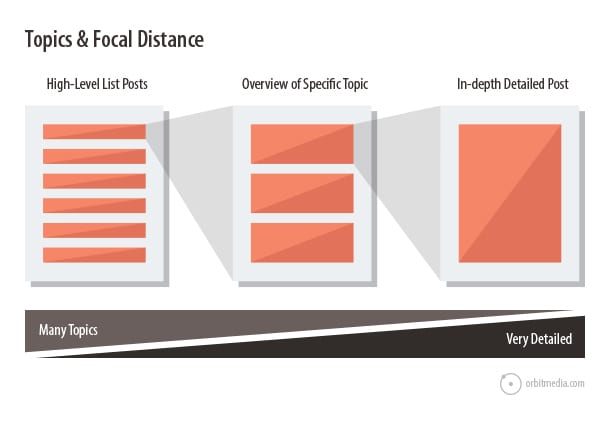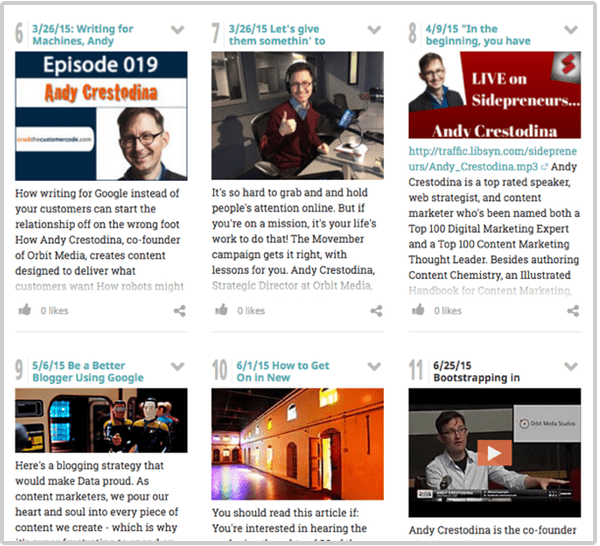You’re an expert. A thought leader. You’re a seasoned, veteran marketer. Or, at least, you’ve been doing this a while.
But are you feeling the grind? Are there ways you could be more efficient? More effective?
The tactics that work in the beginning don’t always work later on. You need to reconsider your approach.
Although any marketer may find these tips useful, this post is specifically for marketers with 5+ years experience creating and promoting content.
1. The Art of Personal Leverage: “Delegation & Automation”
Here’s a question you’ve asked yourself late at night or in the early morning hours.
“Isn’t there a faster, easier way to do this task?”
In the beginning, you did everything by hand. And you’ve gradually tweaked your approach over the years. You’ve slowly optimized your actions and gotten better over time.
But evolution will only get you so far. Sometimes you need a revolution.
Here’s how the question “manual, delegate or automate?” is often answered by content marketers of different levels.
Junior Marketer
All tasks are done manually since the team is small or because work is delegated to you by others.

Mid-level Marketer
You become more efficient by using others to edit and publish your work. More of your work involves collaboration with influencers and other sources of content.

Senior Marketer
You have moved the fulcrum and become far more efficient through delegation and automation. You’ve leveraged yourself as a resource.
 You may do things very differently from these examples, depending on your skills and your team. But the point here is that senior marketers sometimes need to stop and reconsider how the work gets done.
You may do things very differently from these examples, depending on your skills and your team. But the point here is that senior marketers sometimes need to stop and reconsider how the work gets done.
- Let an editor or assistant set up times for you to talk to sources, lineup email interviews and gather contributor quotes.
- Hire a ghostwriter. Send them your “crappy first draft” and let them finish it.
- Set up social media automation so the tweets and posts of your content happen continuously and automatically.
And sometimes, it’s not about delegation or automation. It’s about deciding what NOT to do. Make a DON’T DO list and simply quit doing certain things. Just ask pro copywriter, Henneke Duistermaat.
 |
Expert Insight: Henneke Duistermaat, Enchanting Marketing“To-do lists can be a source of stress. To-do lists fool us into thinking we can easily squeeze a few extra tasks into our week. For instance, setting up an Instagram account and spending 15 – 20 minutes a day on building a following and sharing pictures doesn’t sound like a lot. But your working hours are sneakily increasing. This year, I learned to schedule my work. Instead of cramming more items onto my to-do list, I stopped seeing time as an endless resource and estimated what I could do in the hours available to me. My not-to-do list became as important as the short list of tasks I wanted to focus on. I learned to say no more often because I finally understood that doing an extra task would mean that I’d have to skip something that was on my to-do list.” |
2. Make A List of Everything You Know: Your “LBOW”
How often do people ask you this question?
“Have you ever written something about topic x?”
Of course you have, many times. You’ve written hundreds of articles over the years. This is your lifetime body of work, also known as your “LBOW.” But your content isn’t really organized into a larger cohesive structure.
Time to take a step back and see the big picture.
Rather than writing your next post. Write an outline of your entire body of work. Start with the big topics and add the subtopics under each. Create the structure that every post you’ve ever written fits within.
It’s a powerful exercise in content strategy, with huge potential benefits. Here are a few of the possible outcomes:
- Mega Roundup: Publish the outline as a directory of your content. Link to all the top posts for each topic. It’s the You-pedia. Next time someone asks if you’ve written something, send them this list.
- Mind the Gaps: Notice where there are missing pieces or missing connections. Fill in these gaps with future articles. Write the posts that connect various topics.
- Publish the Book: Now that you’ve got the table of contents in front of you, you’re one huge step closer to publishing. Fill in those gaps, hire an editor, design a cover, send it to the printer …then add the word “author” to your LinkedIn profile.

 |
Expert Insight: Barry Feldman, Feldman Creative“For the prolific content creator, this strategy makes so much sense it almost makes you feel foolish for not recognizing it (or doing it). While I was publishing my SEO book (which is a compilation of sorts), I asked my assistant to compile a spreadsheet of ALL my posts, everywhere. You might be able to guess what happened. I identified several ‘must-do-because-they’re-almost-already-done’ projects for books, content hubs, courses, webinars, and more. I love this idea. Take inventory and LBOW your way to a deeper pool of potential content assets.” |
Step back, look at your LBOW and put your brain onto one piece of paper. What happens next might surprise you.
3. Capture Your Off-Site Articles: “Listly”
If you’ve contributed a lot to other people’s content, you’ve probably asked this question:
“Didn’t I write that as a guest post once? Where is that?”
As you collaborate with more marketers, it gets harder to keep track of things. This is especially true for anyone involved in PR efforts or those who give interviews. Your content is all over the place.
The fix is to keep a list of all guest posts and interviews, but this isn’t a list you keep hidden. This list should be shareable and embeddable. Use List.ly.
Not only does this make everything easy to find and share with others, but you can embed it into a page on your site. Set it to list-view or grid-view. Let people comment or vote for their favorites.

I keep a list of all of my interviews and guests posts for each year. I also use Listly to collect book reviews of Content Chemistry and embed them on the page for the book.
4. Brain Picker Defence: “Office Hours”
How often do you hear this question?
“Can I pick your brain over coffee sometime?”
There are huge networking benefits to meeting with people one-on-one. Personally, my office hours have led to leads, projects and friendships.
But brain pickers can take a lot of time. Just scheduling (and sometimes rescheduling) can take four or five emails back and forth. Here are ways that a senior marketer can make that time more effective, more efficient.
- Ask people to come to you
If they want free advice, they should be willing to come to you or do it over a call. - Use a scheduling tool
Free services like YouCanBook.me make it easy for people to sign up on your terms. No more back-and-forth coordinating times. - Give them homework first
My office hours signup page suggests that people buy and read my book before coming in. If they want my help, they should read my best advice first! - Charge for your time
If you’re a consultant and your business is giving advice, then you should charge for office hours. Advice is what you do after all.

Office hours are a time management tool. They’re a place to send people who reach without a real focus, as in “you should meet my son-in-law.”
 |
Expert Insight: Aaron Orendorff, iconiContent“Charging for your time sounds obvious. What’s counterintuitive is when you should start charging for your time: right from the jump. This means charging even for initial consultations that take place during what we might normally call the “courting” or “lead nurturing” stage. Why start charging so early? Simple … because “if they’re not paying for it, they won’t value it.” |
5. A Collaboration Structure for Busy Experts: “Marketing Mastermind Group”
How often have you said this to yourself?
“She and I always talk about collaborating, but we never seem to find the time.”
A mastermind group is a way to stay connected with your highest-value contacts. These are other senior marketers with similar skills, influence and audience. You can help them and they can help you.
Some mastermind groups are run by professionals and members pay to belong. But anyone can create a mastermind for free. Simply reach out to five or six friendlies on your level and suggest a structure. Here’s an example…
—
Content Marketing Mastermind Group
GOAL: Our purpose is to support the creation and promotion of content for our members. We meet on Skype, Blab or G+ Hangout every month for one year, after which time we will disband.
- Share each other’s content in social media
- Collaborate on content through contributor quotes
- Synchronize publishing calendars to better reference each other’s articles
- Share ideas on productivity, new tools and new tactics
- Make introductions to other marketers and influencers
RULES:
One member is the assigned facilitator. They will manage the calendar and capture notes in a shared document. They will also create a Slack board so people can chat between meetings.
Each member gets roughly equal time. If any member misses two sessions, they are kicked out of the group!
Optional: Each month, the group will select and invite one guest.
—
Groups may have a theme, such as marketing speakers (“The Green Room Group”) or podcasters (“The Podmasters”). Make sure to give the group a badass name.
Now you’ll be sure to spend quality time with those contacts you hardly ever see.
 |
Expert Insight: Ian Cleary, Razorsocial“Mastermind groups are a great way of sharing knowledge and getting support from other entrepreneurs and business owners. But make sure to define the rules and goals in advance. Mastermind is not about chatting. It’s about getting results.” |
Bonus (but highly controversial) Tactic: “The Yank”
Warning: The following tip may be offensive to some marketers. This is not an endorsement or recommendation.
You’ve been on Twitter for a very long time, mentioning, retweeting, favoriting and following back. You have tens of thousands of followers …and you’re following thousands yourself.
You followed back everyone for a long time. But now your home stream is basically noise because you follow so many. It’s so meaningless that you haven’t looked at it in months. Why are you following all these accounts?
Unfollow everyone.
Yank out everyone you follow, Brogan-style. Use an unfollow tool like Manage Flitter to rip off the band-aid quickly. Brace yourself for the fallout and write a post about the value of following only those you are truly connected with.

Now, look at your follower/following ratio. You’re famous! (not really)
 |
Expert Insight: Gini Dietrich, Spinsucks.com“Argh! Why does this still even matter? Do you really want to be perceived as being a Twitter celebrity because you have way more followers than you follow? Does that work? Sure, Twitter isn’t the same enjoyable place it was in 2008 and 2009. It’s full of noisy marketers and salespeople talking about how great they are. And yes, it makes sense to whittle through your followers so you can easily find those you still want to read and talk to. I suppose it’s probably even easier to just do a mass unfollowing and start over (though Twitter may penalize you for that). But this isn’t a magic bullet. You’re still engaging with human beings. Human beings who don’t behave any differently online than they do off. You have to build trust with them. You have to be interested in them. You have to show you care about them. You can’t do that by doing the equivalent of a big, middle finger stuck up in the air as you unfollow them all. Do the hard work. Whittle down your followers slowly. It will be worth the elbow grease in the long run.“ |
Have some tactics that you use? Help your fellow marketers out and leave a comment below.




